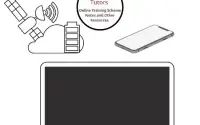Freehand Sketching of Workshop Hand Tools – Basic Technology JSS 1
Basic Technology JSS 1 Second Term Lesson Notes – Week 9
Freehand Sketching II – Sketching of Simple Workshop Hand Tools
Subject: Basic Technology
Class: JSS 1
Term: Second Term
Week: 9
Age: 10 – 12 years
Duration: 40 minutes
Behavioral Objectives
By the end of the lesson, students should be able to:
- Identify different workshop hand tools used in building, woodwork, and metalwork.
- Explain the importance of sketching workshop hand tools.
- Sketch different hand tools used in building, woodwork, and metalwork.
- Apply freehand sketching techniques to represent hand tools accurately.
Keywords
- Freehand Sketching – Drawing without the use of instruments.
- Workshop Tools – Tools used in technical work such as building, woodwork, and metalwork.
- Proportion – The correct size and shape of an object in a drawing.
- Outline – The outer shape of an object.
- Detailing – Adding small features to make a sketch realistic.
Set Induction (Entry Behavior)
- The teacher displays real or pictorial examples of common hand tools.
- Students describe their features and uses.
Learning Resources and Materials
- Drawing book or plain paper
- Pencils (HB, 2B, 4B)
- Eraser
- Ruler
- Samples or pictures of hand tools
Building Background/Connection to Prior Knowledge
Students have learned about freehand sketching and its importance. This lesson applies those skills to sketching hand tools used in workshops.
Embedded Core Skills
- Creativity – Representing tools through drawing.
- Observation – Understanding the shape and structure of tools.
- Hand-eye Coordination – Practicing smooth hand movement for sketching.
Lesson Content
1. Meaning of Workshop Hand Tools
- Workshop hand tools are tools used manually for construction, woodworking, and metalworking.
- They help in cutting, shaping, measuring, and assembling materials.
2. Importance of Sketching Workshop Hand Tools
- Helps in recognizing and remembering different tools.
- Assists in technical drawing and design work.
- Improves drawing and observational skills.
- Useful in developing technical skills for future careers.
3. Types of Workshop Hand Tools and Their Sketches
A. Building Tools
- Trowel – Used for applying and spreading mortar.
- Bricklayer’s Hammer – Used for cutting and breaking bricks.
- Plumb Bob – Used to check vertical alignment.
- Measuring Tape – Used to take accurate measurements.
B. Woodwork Tools
- Hand Saw – Used for cutting wood.
- Chisel – Used for shaping wood.
- Mallet – A wooden hammer for striking chisels.
- Jack Plane – Used for smoothing wood surfaces.
C. Metalwork Tools
- Hack Saw – Used for cutting metal.
- Files – Used for smoothing rough metal surfaces.
- Cold Chisel – Used for cutting metals.
- Ball Peen Hammer – Used for shaping metal.
4. Steps in Sketching Workshop Hand Tools
- Observe the tool carefully – Identify its basic shape.
- Start with light lines – Draw a rough outline.
- Add details – Sketch handles, blades, or measuring marks.
- Darken final lines – Make the drawing clearer.
- Label the parts – Identify key sections of the tool.
Evaluation (Fill in the Blanks with Multiple-Choice Options)
- _______ are used for construction, woodwork, and metalwork.
a) Workshop hand tools
b) Cooking utensils
c) Sports equipment
d) Gardening tools - A _______ is used to check vertical alignment in building construction.
a) Hand saw
b) Plumb bob
c) Chisel
d) Jack plane - The _______ is used for cutting metal.
a) Hack saw
b) Mallet
c) Tape measure
d) Trowel - The first step in sketching a hand tool is _______.
a) Observing its shape
b) Coloring it
c) Writing its name
d) Cutting the paper - The _______ is a wooden hammer used for striking chisels.
a) Ball peen hammer
b) Mallet
c) Claw hammer
d) Plumb bob - A bricklayer’s hammer is used for _______.
a) Breaking bricks
b) Drilling holes
c) Measuring distance
d) Cutting wood - The jack plane is used in _______.
a) Woodwork
b) Metalwork
c) Electrical work
d) Gardening - A _______ is a tool for smoothing rough metal surfaces.
a) File
b) Cold chisel
c) Tape measure
d) Trowel - A hand saw is mainly used to cut _______.
a) Wood
b) Metal
c) Plastic
d) Glass - In sketching, the final lines should be _______.
a) Darkened
b) Erased
c) Left rough
d) Ignored
Class Activity Discussion (FAQs and Answers)
- Why is freehand sketching of hand tools important?
- It helps in recognizing and learning about different tools.
- What are the basic steps in sketching hand tools?
- Observe, outline, add details, darken lines, and label.
- Which tool is used to cut wood?
- The hand saw.
- What is the purpose of a chisel?
- It is used for shaping wood.
- How can one improve freehand sketching?
- By practicing regularly and observing real objects.
- Which tool is used for cutting metal?
- The hack saw.
- What is the function of a plumb bob?
- It checks vertical alignment in building construction.
- What is a jack plane used for?
- Smoothing wood surfaces.
- Why should sketches be labeled?
- To identify parts and understand their functions.
- What should be done before darkening sketch lines?
- Ensure the proportions and details are correct.
Presentation Structure
- Introduction: The teacher explains freehand sketching of hand tools.
- Demonstration: The teacher sketches different tools.
- Student Practice: Students sketch various workshop tools.
- Guidance & Correction: The teacher checks students’ work.
- Recap & Questions: Students summarize what they learned.
Assessment (Short-Answer Questions)
- Define workshop hand tools.
- Mention two reasons why freehand sketching of tools is important.
- Name three types of workshop hand tools.
- How is a bricklayer’s hammer used?
- What is the purpose of a file in metalwork?
- Describe how to sketch a simple tool like a hammer.
- What is the first step in sketching a tool?
- Why is it important to darken sketch lines?
- Name one tool used for shaping wood.
- What is the function of a measuring tape?
Conclusion
The teacher marks students’ work, provides feedback, and encourages further practice on sketching different tools.


